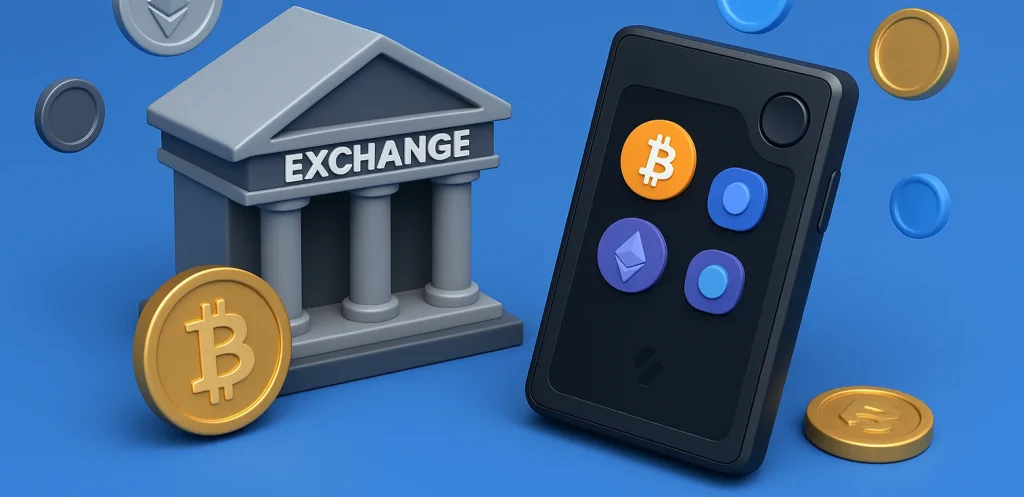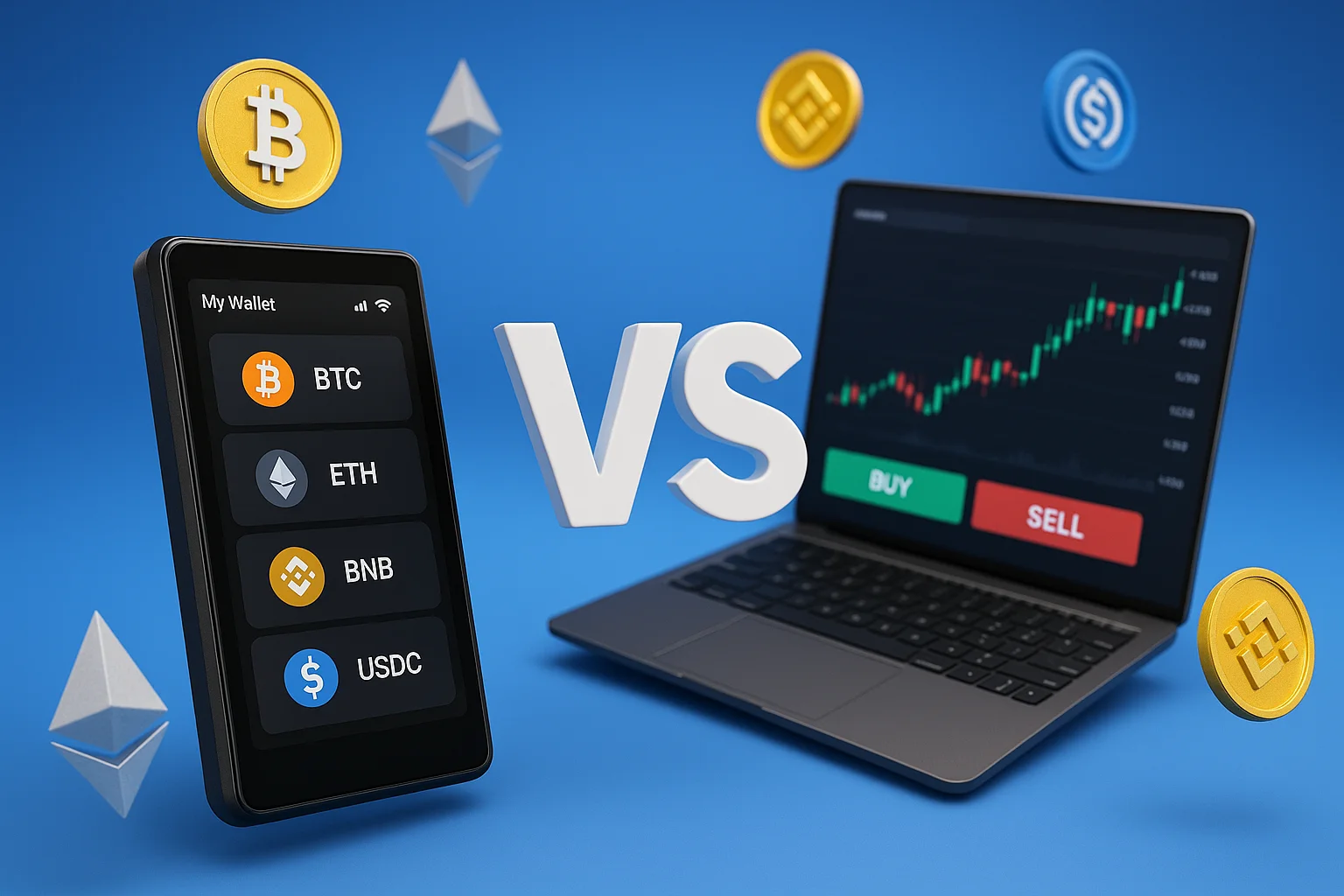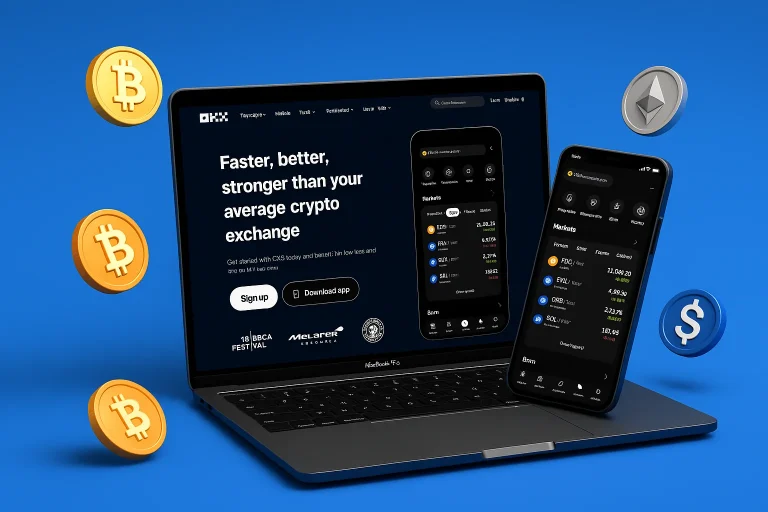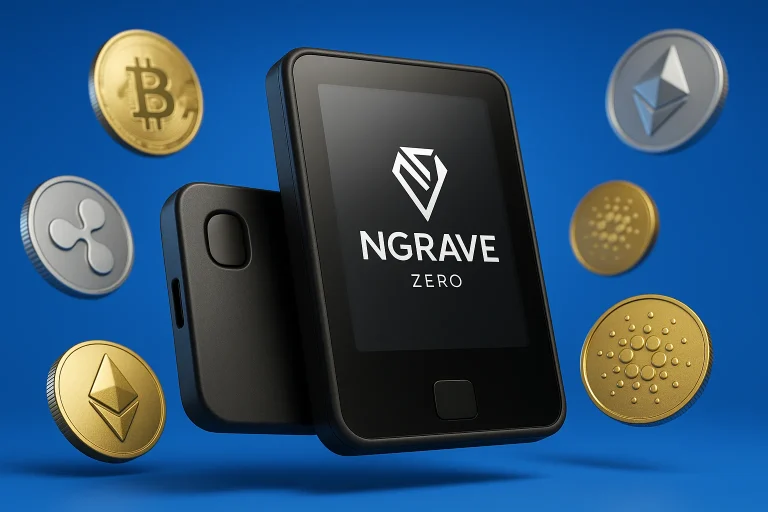If you’re new to crypto or already trading, one big question stands out: where should you store your coins, in a crypto wallet or on an exchange? This choice determines the level of security for your assets, the ease of trading, and the extent of control you truly have.
Many users learn too late that convenience has a cost. Exchanges make trading simple, but they also expose your funds to hacks or system failures. Wallets offer complete control, but losing your keys means losing access forever.
This guide breaks it all down: crypto wallet vs exchange, how each works, their pros and cons, and when to use them. By the end, you’ll know how to keep your assets safe and choose what fits your crypto goals in 2025.
Table of contents
What Is a Crypto Exchange?
A cryptocurrency exchange is an online platform where users can buy, sell, or trade digital assets, including Bitcoin and Ethereum.
The exchange acts similarly to a stock market, matching buyers and sellers in an order book or facilitating peer-to-peer trades. Some exchanges also provide fiat on-ramps (allowing you to deposit traditional money, such as EUR/USD) and off-ramps (for cash-out).
The purpose: to give traders and investors access to liquidity (easy buying/selling), a variety of crypto assets, and tools for managing trades.
Centralized Exchanges (CEXs)
- These are run by companies or organisations that act as intermediaries. They hold custody of users’ funds (you deposit crypto or fiat into the platform).
- They offer high liquidity, easy-to-use interfaces, fiat-to-crypto trading, and often strong regulatory compliance (depending on jurisdiction).
- Trade execution is typically fast, with numerous features (including market orders, limit orders, and margin/trading tools) built in.
- But because they hold users’ funds, they create a single point of failure (risk of hacks, insolvency, regulatory issues).
Centralized platforms, such as Binance, Coinbase, and OKX, operate as custodial trading hubs. Read our full OKX review to see how it compares.
Decentralized Exchanges (DEXs)
- These allow peer-to-peer trading directly from users’ wallets using smart contracts. There’s no central intermediary controlling all funds.
- Users keep control of their private keys (in many cases), which means less custodial risk.
- The trade-off: usually lower liquidity, a steeper learning curve, possibly only crypto-to-crypto (less fiat support), and other risks (smart contract bugs)
How Exchanges Store and Manage User Funds

In a CEX model, when you deposit crypto or fiat, the exchange creates a custodial account. Technically, you have a claim to the asset, but the platform holds the funds.
The exchange utilizes internal order books, matching buy/sell orders, and often holds large amounts of funds in both “hot wallets” (connected to the internet) and “cold wallets” (offline) for enhanced security.
On a DEX, the funds remain in users’ wallets; trades occur by interacting with smart contracts, which automatically swap assets when conditions are met.
Benefits of Using a Crypto Exchange
- Convenience: For newcomers or frequent traders, CEX platforms offer straightforward interfaces, support for fiat deposits, fast trade execution, and high liquidity.
- Liquidity: Many CEXs have high trading volumes and a broad number of trading pairs, which means you can buy/sell large amounts without big price swings.
- Trading tools: Market orders, limit orders, stop-loss orders, margin, and derivative products, many of which are built in. Suitable for trading cryptocurrencies.
Risks of Using a Crypto Exchange
- Custodial risk: When you keep crypto on an exchange, you’re trusting the platform holds it safely. If the exchange fails, your access can be impacted: “not your keys, not your coins” applies.
- Security breaches and hacks: There have been many cases where exchanges lost funds (via hacks, mismanagement, or fraud).
- Regulatory & liquidity risk: Some exchanges may face regulatory issues, freeze withdrawals, or, in extreme cases, become insolvent. Users should verify credentials, history, and regulatory status.
- Less control: If your account is blocked or if the exchange imposes restrictions, your access to funds may be limited.
What Is a Crypto Wallet?
A cryptocurrency wallet is a digital or physical tool that enables you to store, send, and receive cryptocurrencies securely. Unlike an exchange account, a wallet gives you direct control over your private keys, the cryptographic codes that prove ownership of your assets on the blockchain.
When you hold your own keys, you have your crypto. No middleman, no platform dependency. Cryptocurrency wallets encompass a broad category that includes both hot and cold storage solutions.
How Crypto Wallets Work
Every wallet has two main components:
- Public key (address): Similar to a bank account number. You share it with others to receive funds.
- Private key: Like your digital signature. It’s used to access and authorize transactions. If you lose it, you lose access to your crypto; there’s no recovery system.
Wallets don’t “store” coins physically. Instead, they manage the cryptographic information that allows you to interact with the blockchain where your assets live.
Types of Crypto Wallets
1. Hot Wallets
Hot wallets are connected to the internet, making them convenient for daily transactions.
They come as:
- Software wallets: Desktop or mobile apps (e.g., MetaMask, Trust Wallet).
- Browser wallets: Extensions that integrate with DApps or exchanges.
Pros: Fast, user-friendly, ideal for active trading or small balances.
Cons: Internet connectivity exposes them to hacking or phishing risks.
2. Cold Wallets
Cold wallets are offline storage devices, ideal for long-term holding.
They include:
- Hardware wallets: Physical devices (e.g., Ledger, Trezor) that store keys offline.
- Paper wallets: Printed QR codes or key sets.
- Air-gapped wallets: Devices never connected to the internet.
Pros: Top-tier security, immune to online attacks.
Cons: Costlier and less convenient for frequent transactions.
Private Keys and Seed Phrases
When setting up a wallet, you’ll receive a seed phrase (usually 12–24 words). This is your backup key; anyone with it can access your funds.
Keep it offline, write it on paper, and store it securely. Never share it or store it digitally in the cloud or email accounts. Storing private keys offline is the safest approach for long-term holdings. Keep backups in secure physical locations.
Benefits of Using a Crypto Wallet
- Full control: You own and manage your funds without relying on third-party platforms.
- Enhanced security: Especially when using cold storage methods.
- Privacy: Transactions can remain pseudonymous and independent of centralized systems.
A secure wallet gives you both control and peace of mind when you follow best practices.
Risks of Using a Crypto Wallet
- Key loss: Losing your private key or seed phrase results in the permanent loss of funds.
- Device theft or damage: Without proper backups, your assets could become inaccessible.
- User error: Sending crypto to the wrong address or using the wrong network can’t be reversed.
Exchange vs Crypto Wallet: The Main Differences

Control Over Funds
The key difference between a wallet and an exchange lies in the custody of funds. On an exchange, your assets are held by the platform, meaning you rely on a third party to safeguard them. In contrast, a crypto wallet gives you complete control; only you can access your private keys, sign transactions, and move funds.
Security & Risks
Exchanges invest heavily in cybersecurity, but they remain prime targets for hacks and can suffer outages or freezes. Wallets, especially cold wallets, minimize online exposure and are safer for long-term storage.
However, security depends on the user’s habits; losing private keys or mishandling backups can lead to irreversible losses.
Accessibility & Ease of Use
Exchanges are more beginner-friendly. You can trade, convert, or withdraw with a few clicks. Wallets, on the other hand, require users to manage seed phrases and network settings, which can feel complex at first.
Still, wallets offer greater flexibility for interacting with decentralized applications (DApps) and storing multiple assets.
Fees & Costs
Exchanges typically charge trading and withdrawal fees, which can vary based on the platform and transaction volume. Wallets don’t charge management fees, but they may incur network fees (also known as gas) when sending cryptocurrency.
Over time, self-custody through wallets can be more cost-efficient for holders, while exchanges are better suited for frequent traders.
Use Case Comparison Table
| Feature | Crypto Wallet | Crypto Exchange |
| Best For | Long-term storage and savings; | Active trading and quick conversions; |
| Custody | User-controlled (you hold your private keys); | Platform-controlled (custodial); |
| Security | Higher, especially with cold storage; | Lower, vulnerable to hacks or restrictions; |
| Accessibility | Moderate, setup required; | Very high, simple to use and fast trades; |
| Fees | Network (gas) fees only; | Trading and withdrawal fees; |
| Risk Level | User error or key loss. | Platform hacks or account freezes. |
How to Move Crypto from Exchange to Wallet (Quick Guide)
Moving your crypto from an exchange to a personal wallet is one of the best ways to secure your assets. Follow these simple steps to transfer assets safely and avoid common mistakes.
- Step 1: Get Your Wallet Address
Open your wallet (software, hardware, or mobile) and find the “Receive” option. Copy your public address or scan the QR code for the cryptocurrency you want to transfer. Always double-check that you’ve selected the correct asset (e.g., BTC, ETH). Confirm the address visually before proceeding to ensure you’ll send funds to the correct address.
- Step 2: Go to Your Exchange Withdrawal Page
Log in to your crypto exchange account and open the “Withdraw” or “Send” section. Choose the same cryptocurrency and paste your wallet address in the recipient field.
- Step 3: Choose the Correct Network
Ensure the blockchain network type matches between your wallet and the exchange (for example, ERC-20 for Ethereum or BEP-20 for BNB Smart Chain). Sending to the wrong network can permanently lock your funds.
- Step 4: Enter the Amount and Confirm
Enter the amount you want to send. If it’s your first transfer, start with a small test amount to ensure everything works correctly. Review the transaction fee and confirm the withdrawal.
- Step 5: Verify and Track the Transfer
Most exchanges send a confirmation email or 2FA prompt to verify withdrawals. Once approved, you can track your transaction using a blockchain explorer (like Etherscan or Blockchain.com) to see when it’s confirmed.
Security Tips When Transferring
- Never share your private keys or seed phrase; they’re for your eyes only.
- Bookmark official exchange and wallet sites to avoid phishing attempts.
- Always verify wallet addresses manually; avoid copying from screenshots or messages.
- For large transfers, use a hardware wallet for maximum security.
Avoiding Network Errors and Scams
- Send only through compatible networks to prevent irreversible loss.
- Be cautious of fake wallet apps or exchange clones; download only from official sources.
- Always test with a small transfer first, then move larger amounts once confirmed.
FAQ
For beginners, software or mobile wallets like Trust Wallet or MetaMask are the easiest to start with. They’re free, simple to use, and work directly with exchanges and decentralized applications (DApps). As your holdings grow, consider upgrading to a hardware wallet for stronger security.
Yes, and it’s often the best strategy. Use the exchange for buying, selling, or short-term trading, and move your long-term holdings to a wallet you control. This approach balances convenience and security.
Not directly. To convert crypto into cash, you’ll need to transfer your funds back to an exchange that supports fiat withdrawals, then withdraw to your bank account. Wallets are primarily designed for storage and transactions, rather than cashing out.
Simply holding crypto in your wallet isn’t a taxable event in most countries. Taxes usually apply when you sell, trade, or convert crypto to fiat. Always check your local tax regulations to stay compliant.
Top choices in 2025 include the Ledger Nano X, Trezor Model T, and BitBox02 for hardware wallets, as well as MetaMask, Exodus, and Trust Wallet for software options. The best one depends on your needs: security, ease of use, or multi-chain support. If you’d like to learn more about Trezor Model T vs Ledger Nano X, make sure to check out this detailed comparison guide.
Final Thoughts
Choosing between a crypto wallet and an exchange depends on your goals and risk tolerance. Exchanges offer speed and convenience for trading, while wallets (especially cold ones) provide stronger security and complete control.
In 2025, the best approach is a hybrid one: trade on exchanges and store savings in a private wallet. Understanding the differences between crypto wallet vs exchange helps you protect your assets and stay in control of your crypto journey.




